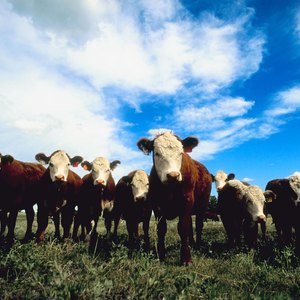
Ranchers and outside investors alike are bullish about beef as market conditions in 2013 seem to bode well for a rally in cattle prices in coming months. Historically low inventory and a series of drought conditions threatening grain crops are setting the stage for a potential bull run in more ways than one. For those participating in the domestic beef futures markets, your choices include live cattle and feeder cattle futures on CME, or the Chicago Mercantile Exchange. Live cattle are older than feeder cattle, the latter which at 650 to 849 lbs, require more time to reach slaughter weight.
Buy Cattle Futures
Investing in beef futures can take a number of forms. Depending on your goals, you may be interested in preserving the value of the commodities you have on hand, or you may want to avoid having to pay more to buy beef inventory in the future. You may not have these objectives, and simply want to play trends in the market to make money. When you invest in beef by buying cattle futures on an exchange, you are hoping to capitalize on any future price increases in cattle. For that privilege, you pay a certain amount of margin, or a deposit that allows you to initiate a trade. The contract will be designated at a certain price for a standardized amount of cattle, slated to expire on a specific month in the future. If the price of cattle futures goes up to a desirable level, you can sell your futures at the new price and thus pocket the difference. A small price fluctuation is magnified in futures, because a single contract comprises a large unitized quantity. In the case of feeder cattle, that would be 50,000 lbs. Thus, a 10 cent increase can result in a $5,000 gain.
Sell Cattle Futures
While there may be high optimism for potential highs in the beef markets, you can never be sure how the markets will behave. If you believe that prices are not quite ready to take off but rather, seasonal tendencies or other fundamental factors will send cattle prices lower, you might sell cattle futures. Selling contracts of a certain price now will give you the opportunity to buy the futures when your predicted price range approaches. If prices then drop, it will be profitable to buy at the now lower price. For instance, if you sold one May feeder cattle contract in March for $.90 per lb and bought it before May in order to exit the position at $.80 per lb, you will have achieved a profit.
Long Hedge
The way a food processing company might invest in beef futures is by implementing what is called a long hedge. This technique allows the processor, who anticipates having to buy a large amount of beef in the next few months even though beef prices may rise, to position itself to recoup any losses. It would look at cattle futures contracts for the months that are closest to the timeframe of beef purchase. By buying a suitable number of contracts equivalent to the amount of beef to be purchased, it could allow itself to sell those contracts for a profit (if the difference between cash and futures has not varied detrimentally in the meantime). Thus, though the food company still ends up buying higher priced beef, the sale of futures compensated for some if not all of the loss.
Short Hedge
By a similar token, ranchers who plan to sell cattle at some point in the future might institute a short hedge to protect their profits when it comes time to sell. In their case, they would attempt to lock in a favorable, or high price, by selling live or feeder cattle futures. They would select contracts with a view to buying the futures come selling time for their merchandise. At the time of selling the actual beef, any resultant loss due to a price decline in the beef market would ideally be made back through the purchase of the futures. Hedges of either type are not always beneficial: if cash or futures prices go against your predictions, you may have losses greater than if you had not hedged.
References
Resources
Writer Bio
Timothea Xi has been writing business and finance articles since 2013. She has worked as an alternative investment adviser in Miami, specializing in managed futures. Xi has also worked as a stockbroker in New York City.

